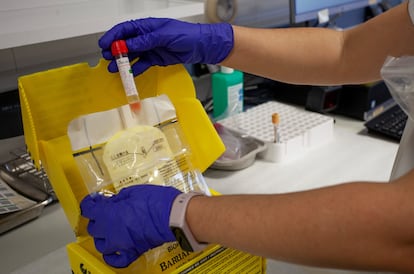The search for a new Covid-19 monitoring system
The sentinel network has been used for many years to keep tabs on the flu, but not all European countries have one in place

Assuming the coronavirus does not cause any new nasty surprises – something that can never be completely ruled out – the sixth wave of the pandemic that is currently waning in Spain could be the last where the health authorities are counting every single positive case. That’s the intention, anyway, with months of work already having been put into the search for a new monitoring system that would allow for tracking of the virus with fewer resources, something that would also lead to a more natural way of living with the virus.
A sentinel surveillance network, of the kind used to monitor influenza, is the preferred choice for many public health specialists: it’s solid, it has proved to be trustworthy for many years, and Spanish regions have put pilot schemes into place to roll it out to all respiratory illnesses, including Covid-19.
It is made up of a network of primary healthcare doctors located across the country and who cover approximately 2% of the population, and whose patients are demographically representative: i.e. they treat the appropriate proportion of men, women, seniors, and in both rural and urban environments. These physicians collect samples for laboratory analysis from patients with respiratory symptoms and this data serves as the basis for a kind of survey: they can be extrapolated to the rest of the population to analyze how each pathogen is advancing, when infections are rising or falling. At the same time, in hospitals, there is a similar network that serves to calculate how many of these cases are serious.
Such a surveillance system has everything in its favor to be used for Covid-19 apart from one thing: not all European countries have one in place. And in order to have standardized databases that can be compared throughout the European Union, it is necessary for them all to operate under the same procedures.
Spain is one of the countries that is driving this paradigm change in Europe. This is something that has been welcomed by the European Centre for Disease Prevention and Control (ECDC) as well as some member states. The debate now, sources from the Spanish Health Ministry say, is for the new protocol to be implemented across the continent.

The sentinel surveillance network is still on the table, but if the rest of the countries in question are not in a situation whereby they can set it up in time, there will also be the possibility of putting other, less-sophisticated options in place, such as extrapolating from hospital admission data in order to count the number of infections. This surveillance method is much simpler but it also has a lower capacity for predicting waves, and is always somewhat behind the curve because only the most-serious cases are detected.
La Rioja is one of the Spanish regions that is currently working on a pilot scheme using a surveillance network to track respiratory illnesses. As well as the flu, they have included Covid and other viruses, such as respiratory syncytial virus. Eva Martínez, the head of Public Health Epidemiology in that region, explains that the results that these tests return are very similar to the real cases of Covid-19: a sample from just a small number of doctors is able to measure the waves and their trends with a precision that is similar to that obtained by testing all suspected infections.
In La Rioja, a pediatrician and a regular physician from each healthcare center are taking part in this network. They request laboratory analysis of their five first patients of the day with respiratory symptoms. “Epidemiological information is collected from all of them, including clinical characteristics, risk factors, whether or not they are vaccinated…,” explains Martínez.
From there they are taken to the laboratory at San Pedro Hospital, where Míriam Blasco Alberdi works as a microbiologist. “We do a PCR and we send the positive samples to be sequenced,” she explains. “That way we can check whether there are mutations or new variants. This data is sent to the ECDC and the World Health Organization. In the case of the flu, the information that is collected by the laboratories in the Northern Hemisphere serves to design the vaccine for the next season in the south, and vice versa. With the coronavirus, if it becomes a seasonal pathogen, something similar will no doubt happen.”
Tu suscripción se está usando en otro dispositivo
¿Quieres añadir otro usuario a tu suscripción?
Si continúas leyendo en este dispositivo, no se podrá leer en el otro.
FlechaTu suscripción se está usando en otro dispositivo y solo puedes acceder a EL PAÍS desde un dispositivo a la vez.
Si quieres compartir tu cuenta, cambia tu suscripción a la modalidad Premium, así podrás añadir otro usuario. Cada uno accederá con su propia cuenta de email, lo que os permitirá personalizar vuestra experiencia en EL PAÍS.
¿Tienes una suscripción de empresa? Accede aquí para contratar más cuentas.
En el caso de no saber quién está usando tu cuenta, te recomendamos cambiar tu contraseña aquí.
Si decides continuar compartiendo tu cuenta, este mensaje se mostrará en tu dispositivo y en el de la otra persona que está usando tu cuenta de forma indefinida, afectando a tu experiencia de lectura. Puedes consultar aquí los términos y condiciones de la suscripción digital.
More information
Últimas noticias
NASA discovers Titan doesn’t have an ocean, but a ‘slushy ice layer’ that increases possibility of life
Innocence lost in the forest of the child soldiers: ‘Each leader of the armed group had his girls’
‘Fallout’ or how the world’s largest company turned an anti-capitalist apocalyptic Western into a phenomenon
From inflation to defending migrants: Eileen Higgins and Zohran Mamdani inaugurate the new Democratic resistance against Trump
Most viewed
- Christian Louboutin: ‘Young people don’t want to be like their parents. And if their parents wear sneakers, they’re going to look for something else’
- ‘El Limones’ and the growing union disguise of Mexican organized crime
- The low-cost creative revolution: How technology is making art accessible to everyone
- ‘We are dying’: Cuba sinks into a health crisis amid medicine shortages and misdiagnosis
- Liset Menéndez de la Prida, neuroscientist: ‘It’s not normal to constantly seek pleasure; it’s important to be bored, to be calm’











































